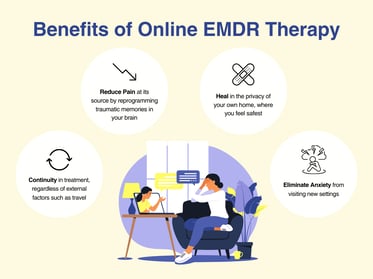EMDR Therapy Online: What You Need to Know - Trillium Counselling
The year 2020 resulted in unprecedented changes, one of which was the widespread adoption of online therapy due to the global pandemic. As we grappled with this new normal, therapy sessions transitioned from in-person to virtual spaces, presenting unique challenges as well as new opportunities. One therapeutic approach that successfully made this shift is Eye Movement Desensitization and Reprocessing (EMDR) therapy. Almost 4 years later, online EMDR (aka virtual EMDR) continues to thrive as a favored and accessible choice, reaffirming its enduring popularity among those seeking effective and convenient therapeutic interventions.
Let’s explore what you need to know about EMDR online therapy – the process, its effectiveness, and considerations for a seamless experience.
What is EMDR and What Are The Benefits Of This Therapy?
EMDR is a psychotherapy approach designed to help individuals process distressing memories and alleviate the associated emotional and physiological distress. It involves a structured eight-phase protocol that includes bilateral stimulation, such as eye movements, to facilitate the adaptive processing of traumatic memories.
EMDR therapy provides various advantages, such as reducing emotional distress, empowering individuals to confront challenges with strength and resilience, and offering valuable tools to manage and understand emotions more effectively.
What Can EMDR Help With?
EMDR therapy has demonstrated its effectiveness in addressing a wide range of mental health concerns, as supported by scientific studies. Specifically, research indicates that EMDR may be beneficial in treating post-traumatic stress disorder (PTSD), alleviating negative emotions stemming from adverse life events, and even mitigating somatic symptoms such as pain or muscle tension. Studies also suggest that EMDR can contribute to the improvement of various mental health conditions, including:
- Trauma & PTSD
- Depression
- Panic disorder
- Psychosis
- Anxiety
- Eating disorders
- Chronic pain
- Substance use disorders
EMDR is a well-versed tool for addressing many of the challenges we may face throughout our lives. Wouldn’t it be convenient to have EMDR therapy in the comfort of your own home?
Can EMDR Therapy Be Done Virtually?
Let’s get straight to it, yes EMDR online therapy is possible and has gained increasing popularity year over year! You may be wondering about its efficacy compared to traditional in-person sessions. According to the National Library of Medicine, a noteworthy 88% of clients reported feeling extremely or very comfortable with the online delivery of EMDR therapy. Moreover, an efficacy trial conducted by Jennifer Hecker DuVal et al., MSW, LCSW, DBH, and certified EMDR specialist, involved 288 virtual EMDR patients and revealed no significant differences between the outcomes of virtual sessions and their in-person counterparts. These findings not only underscore the feasibility of virtual EMDR therapy but also emphasize its capacity to provide the crucial support individuals seek, tailored to the demands of their unique lives.
The research of online therapy in general has been studied and found to be highly effective (Barack et. al, 2007).
Benefits of Online EMDR in Ontario
Virtual EMDR therapy caters to diverse needs, making it an optimal choice for individuals in various circumstances such as:
- Those with busy schedules or frequent travelers seeking consistent counseling, regardless of their location.
- Individuals in remote areas facing limited access to therapy.
- Those who feel anxiety from visiting new settings.
- Individuals who do not have access to reliable transportation.
- Those who are most comfortable in their own homes.
As previously mentioned, virtual EMDR is proven to be as effective as in-person sessions, ensuring the support you need aligns seamlessly with your lifestyle.

How Is EMDR Online Therapy Different From In-Person EMDR Therapy?
The feedback we have received from clients that transitioned from EMDR in office to virtual EMDR has been largely positive. Generally, most clients experienced a small adjustment period but overall, they felt comfortable with processing online and stated minimal disruption during transition.
Clients that are transitioning to virtual EMDR therapy might need a session or two to reassess goals and to build their comfort with meeting virtually. But just as in person, the standard 8 phase EMDR protocol can be used in a fairly traditional manner in virtual therapy.
For new clients, just as you would have in office, you would have an assessment, history taking and resource building phase before moving into the reprocessing or desensitizing phase of EMDR. You would establish safety steps and support systems and practice using them before shifting into EMDR. Eventually you very much feel like there is a routine and structured approach to your online sessions.
Some Considerations For Virtual Therapy
A therapist office environment is set up in a way that creates a sense of safety, comfort, calmness and confidentiality. When you are adjusting to therapy at home there are some things you want to consider in terms of your environment.
-
Can you find a space where you can speak uninterrupted by kids?
-
Are you restricted to common areas that have a lot of noise?
-
Do you feel like you can speak safely without worrying about someone overhearing what you are saying or working on, in your session?
-
Do you have headphones and a webcam on your device?
-
Will you at some point have access to a computer instead of just a phone or ipad?
Some clients don’t want to process trauma in a space that they usually use to calm down from their triggers because it can contaminate or taint the feeling of the space.
How Does Bilateral Movement/Taxation Work if I’m Not In The Office?
Typically, in an in-office session, a therapist will get you to follow their fingers or a light bar to create taxation through eye movement.
Pulsers or tapping is used to create physical taxation and headphones are used to create taxation through auditory sensory. There are a variety of different methods that can be used to create physical, eye or auditory taxation online.
When it comes to eye movement you can decide with your therapist if you want to follow their fingers through the screen (assuming there is enough screen space to create eye movement). A creative way to create eye movements is to place post-it notes either on the corner of the computer or on the wall in front of you, far enough apart to create eye movement and when it comes time to process moving your eyes back and forward between the established points.
There are many different YouTube videos made specifically to create eye movement and also provide audio movement (with headphones). There are apps that can be bought that allow for the therapist to control the taxation methods, speeds, direction from their computer. Clients also have the option of tapping on themselves to create a physical taxation, which can also be done at a very slow and calming state at the end of the session when containment and calm place are done.
With more therapists becoming familiar with the work of EMDR 2.0 you can determine with your therapist additional non-bilateral stimulation methods of taxing the brain, such as counting or multiplying or creating more challenging ways of tapping.
With EMDR 2.0 you can get creative or have fun with your clients by creating different ways of taxing the working memory, such as getting clients to list different breeds of dogs, silly but effective.
What Happens When There Is Internet Interruption During EMDR?
This is a conversation you should have with your therapist.
What if the doorbell rings, your phone rings, or one of the kids enters the room unexpectedly?
The circumstances of your living situation would determine what needs to be explored as possible interruptions, each plan would be based on the person’s feelings, needs or comfort level.
You and your therapist will have a plan in place for the situation where the internet connection cuts out.
How To Prepare Before an Online Session of EMDR Therapy?
Have your supports be aware that you have your session to help minimize interruptions.
Before your EMDR session you are going to want to make your space comfortable and make it so that you don’t have to get up from the computer often. For example, make sure you have tissues close by, water, you have gone to the washroom beforehand, maybe your beloved pet comes into the session with you, or you remove them before the session depending on your preference.
How Does An EMDR Session End in an Online Setting?
In the same way that it would in an office session, EMDR ends based on your own personal needs of what helps calm your body and mind.
For some clients, they do a containment exercise where you visualize putting away the content of the session for the time being. You can also create a calm space, use the smell of a calming scent (eg. candle, spice, clothes of a loved one), listen to music or do a few yoga postures to bring the mind to focus on the body.
Whatever the exercise is, after an EMDR session your therapist guides you through the exercises that have been established to work for you.
Giving yourself some extra time to transition out of your session is a great idea as well. The benefit of being at home is that you can go for a walk, take a bath, talk to your support person or do some home exercises immediately following the session.
The Good News Is You Don’t Need To Postpone Addressing Your Triggers!
At Trillium Counselling, our therapists are trained and certified to provide exceptional care to clients. Their EMDR training and experience equips them with the skills and knowledge needed to guide clients through what can be a transformative process of Eye Movement Desensitization and Reprocessing.
Curious about other forms of online counselling? Check out our recent post on Online Couples Counselling.Online Therapy Effectiveness Reference: Barak, A., Hen, L., Boniel-Nissim, M., & Shapira, N. A. (2008). A comprehensive review and a meta-analysis of the effectiveness of internet-based psychotherapeutic interventions. Journal of Technology in Human services, 26(2-4), 109-160.
Trillium Counselling provides online counselling services and EMDR Therapy in the Kitchener Waterloo area. Contact us today for a consultation or to book an appointment!
%20(1).png?width=200&height=80&name=Trillium%20Counselling%20Logo%20(999%20x%20398%20px)%20(1).png)


